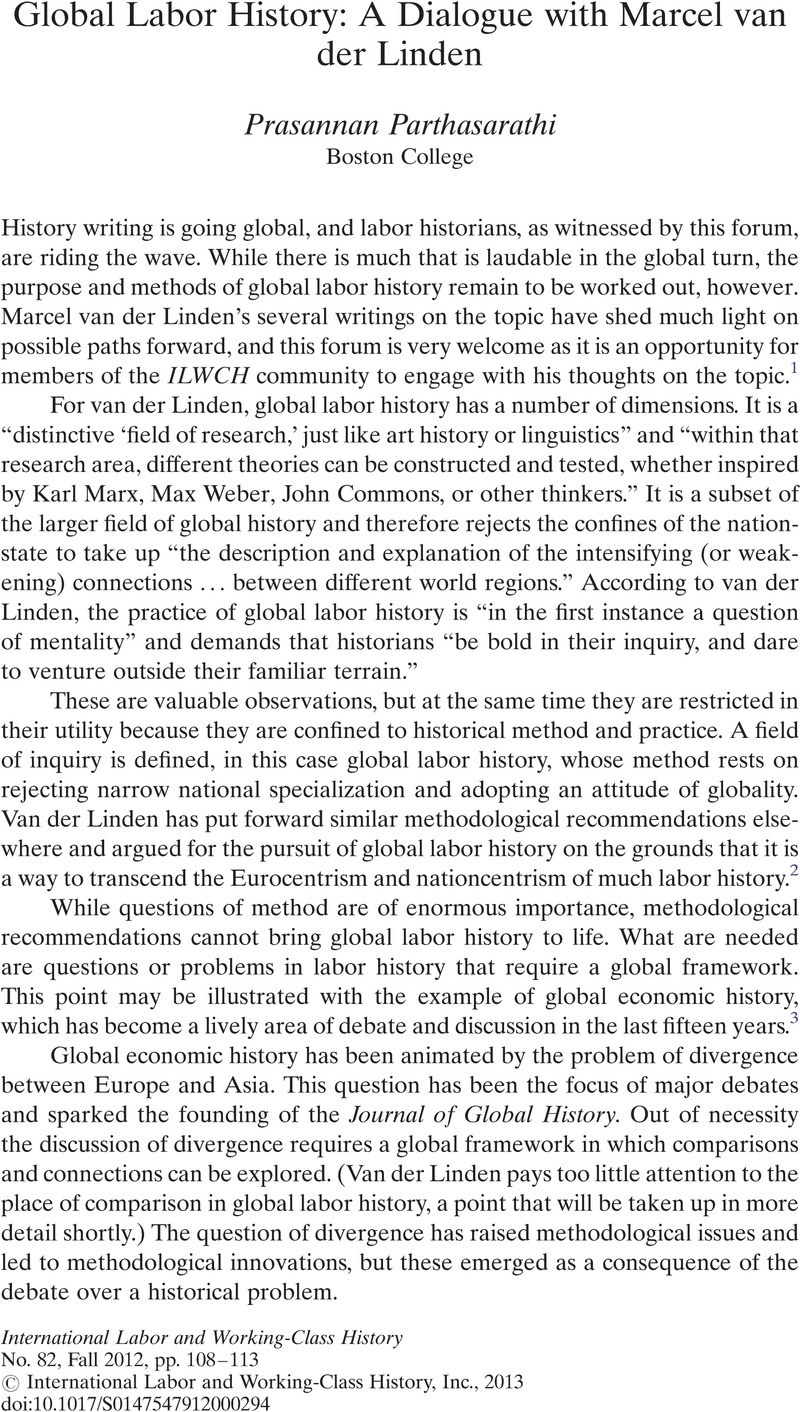No CrossRef data available.
Article contents
Global Labor History: A Dialogue with Marcel van der Linden
Published online by Cambridge University Press: 08 March 2013
Abstract

Information
- Type
- Responses
- Information
- Copyright
- Copyright © International Labor and Working-Class History, Inc. 2013
References
Notes
1. In addition to the essay in this volume, see van der Linden, Marcel, Workers of the World: Essays Towards a Global Labor History (Leiden, 2008)CrossRefGoogle Scholar and van der Linden, Marcel, “Labour History Beyond Borders,” in Histories of Labour: National and International Perspectives, ed. Allen, Joan, Campbell, Alan and McIlroy, John (Pontypool, Wales, 2010), 353–83Google Scholar.
2. Van der Linden, “Labour History Beyond Borders.”
3. See Pomeranz, Kenneth, The Great Divergence: China, Europe, and the Making of the Modern World Economy (Princeton, NJ, 2000)Google Scholar and Parthasarathi, Prasannan, Why Europe Grew Rich and Asia Did Not: Global Economic Divergence, 1600–1850 (Cambridge, 2011)CrossRefGoogle Scholar.
4. Parthasarathi, Prasannan and Riello, Giorgio, “Introduction,” in The Spinning World: A Global History of Cotton Textiles, 1200–1850, ed. Riello, Giorgio and Parthasarathi, Prasannan (Oxford, 2009), 12Google Scholar.
5. Bloch, Marc, “A Contribution Towards a Comparative History of European Societies,” in French Studies in History, vol. 1, ed. Aymard, Maurice and Mukhia, Harbans, (New Delhi, 1988), 44Google Scholar. Also see Parthasarathi, Prasannan, “Comparisons in Global History,” in Writing the History of the Global: Challenges for the 21st Century, ed. Berg, Maxine (Proceedings of the British Academy, Oxford, in pressGoogle Scholar).
6. Bloch, “Contribution,” 42, 44.
7. Both Dipesh Chakrabarty and Rajnarayan Chandavarkar make this point but from very different premises and in very different ways. Chakrabarty, Dipesh, Rethinking Working Class History: Bengal 1890–1940 (Princeton, 1989)Google Scholar and “Trade Unions in a Hierarchical Culture: The Jute Workers of Calcutta, 1920–50,” in Subaltern Studies II: Writings on South Asian History and Society, ed. Guha, Ranajit (Delhi, 1984)Google Scholar. Chandavarkar, Rajnarayan, The Origins of Industrial Capitalism in India: Business Strategies and the Working Classes in Bombay, 1900–1940 (Cambridge, 1994)CrossRefGoogle Scholar; “Workers' Politics and the Mill Districts in Bombay between the Wars,” Modern Asian Studies, 15 (1981), 603–47CrossRefGoogle Scholar.
8. Brown, Elizabeth A. R., “The Tyranny of a Construct: Feudalism and Historians of Medieval Europe,” American Historical Review, 79 (1974), 1063–88CrossRefGoogle Scholar; Reynolds, Susan, Fiefs and Vassals: The Medieval Evidence Reinterpreted (Oxford, 1994)Google Scholar.
9. See the essays in Feudalism and Non-European Societies, ed. Byres, T. J. and Mukhia, Harbans (London, 1985)Google Scholar.
10. See Parthasarathi, Prasannan, “Was There Capitalism in Early-Modern Indian History?” in Rethinking a Millenium: Perspectives on Indian History from the Eighth to the Eighteenth Century: Essays for Harbans Mukhia, ed. Datta, Rajat (New Delhi, 2008), 342–60Google Scholar.
11. See Chandavarkar, Rajnarayan, “Industrialization in India before 1947: Conventional Approaches and Alternative Perspectives,” Modern Asian Studies 19 (1985): 623–68CrossRefGoogle Scholar.

